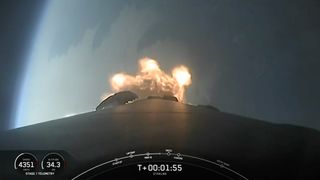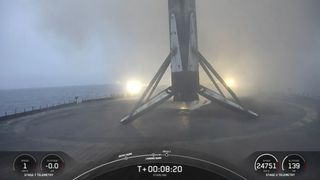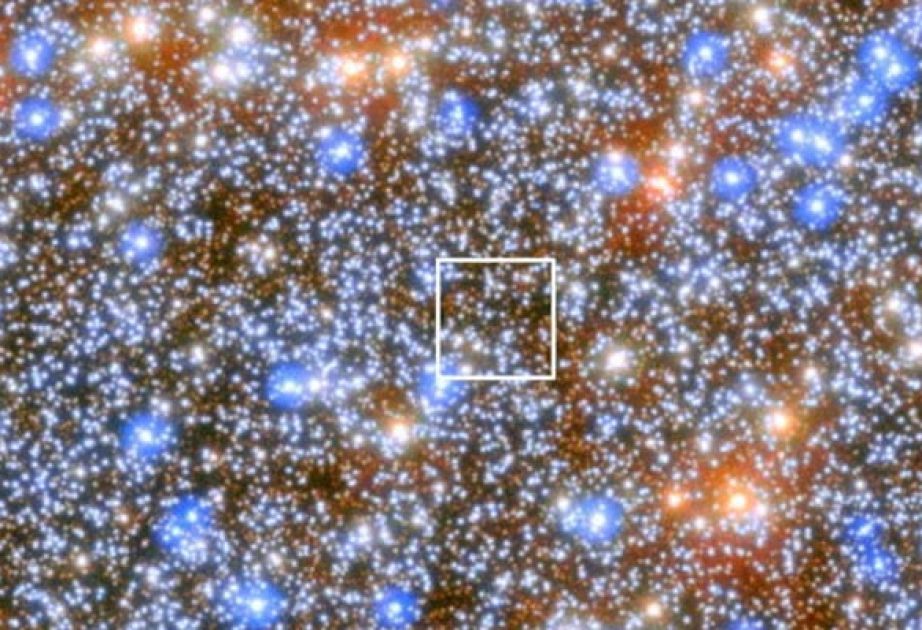Marc Boucher July 12, 2024

It’s been two years since the Webb telescope began to deliver the science that was hoped for. To mark that anniversary a new image was released today (above) and shows “the interacting galaxies of Arp 142 that combines Webb’s NIRCam and MIRI instrument images.”
NASA EVALUATING EUROPA CLIPPER’S ABILITY TO WITHSTAND RADIATION AS LAUNCH NEARS
By Marcia Smith | Posted: July 12, 2024
Three months before the scheduled launch of the $5 billion Europa Clipper mission, NASA has revealed that it is evaluating whether the spacecraft can withstand Europa’s intense radiation environment. At least some of the transistors that control the flow of electricity to operate spacecraft systems are not as radiation resistant as expected. Testing is underway to better understand the implications.
Scheduled for launch on October 10, Europa Clipper will study Jupiter’s moon Europa. Covered in ice, some scientists believe a liquid ocean flows underneath with plumes occasionally erupting through the ice. Life as we know it needs water and where there’s water there may be life prompting intense interest in whether microbial life could have evolved in Europa’s ocean. Clipper will orbit Jupiter and make about 50 passes of Europa, getting as close as 25 kilometers (16 miles) to study any ocean residue that may be on the surface. If lucky, it might even fly through a plume.

The intense radiation environment around Jupiter means the spacecraft’s electronics must be hardened to survive those repeated swingbys. Jupiter’s magnetic field is 20,000 times stronger than Earth’s, creating the most punishing radiation environment in the solar system, second only to the Sun.
Radiation-hardened spacecraft components are not uncommon. They’re needed for Earth-orbiting spacecraft that fly through the Van Allen belts and national security satellites designed to survive nuclear detonations.
Clipper’s electronics are protected by an approximately 1-centimeter (half-inch) thick aluminum “vault” that was closed up tight last October.

In May, about the same time the spacecraft was shipped to Kennedy Space Center in preparation for launch, the Europa Clipper team was “advised that similar parts were failing at lower radiation doses than expected,” NASA said yesterday.

The problem isn’t limited to Clipper. An industry-wide alert went out in June and NASA said “the issue that may be impacting the transistors on Europa Clipper is a phenomenon that the industry wasn’t aware of and represents a newly identified gap in the industry standard radiation qualification of transistor wafer lots.”
Europa Clipper was built at and the program is managed by the Jet Propulsion Laboratory in Pasadena, CA. The Johns Hopkins University Applied Physics Lab (APL) in Laurel, MD designed the spacecraft body in collaboration with JPL and NASA’s Goddard Space Flight Center in Greenbelt, MD. Testing is underway at JPL, APL and Goddard to ascertain how many of the transistors may be susceptible. NASA said data obtained so far “indicates some transistors are likely to fail” and NASA is evaluating options to maximize their longevity. A preliminary analysis is expected at the end of this month.
The spacecraft is already in the final stages of processing for launch on a SpaceX Falcon Heavy during a 21-day window that opens on October 10. That provides some leeway, but if a resolution can’t be found by the end of October, the mission will have to wait until the planets are correctly aligned once again. Clipper needs gravity assists from Mars and Earth to reach Jupiter. After leaving Earth it goes around Mars, then back to Earth, then off to Jupiter, a so-called Mars Earth Gravity Assist or MEGA trajectory.
NASA declined to answer questions today, including how long it’ll be until that next launch opportunity arises, saying all the information they will provide for now is in the blog post

NASA’s science priorities are guided by Decadal Surveys produced by the National Academies of Sciences, Engineering, and Medicine. A mission to Europa was the second highest priority in the 2011 planetary science Decadal Survey, with Mars Sample Return as the highest.
Budget constraints during the early years of the Obama Administration sharply limited NASA’s plans for Mars Sample Return and the agency had no plans to pursue a Europa mission, but Rep. John Culberson (R-TX), who became chair of the House Appropriations Commerce-Justice-Science subcommittee in 2015, had other ideas. Passionate about the possibility of finding life in Europa’s ocean, for all four years that he chaired the subcommittee he directed NASA to build not only an orbiter, but a lander, by specific dates and launch them on NASA’s Space Launch System rocket. The language was in the bill itself, making it the law of the land not just a recommendation in the accompanying report. Culberson often proudly proclaimed that Europa Clipper was the only NASA mission required by law.
Culberson lost his reelection bid in 2018, but Europa Clipper was far enough along that its future was secure even as costs grew to $5 billion despite replacement of the ICEMAG instrument with a less expensive model. Talk of a subsequent lander has faded, however, and Congress was finally convinced that Falcon Heavy was a better choice for the rocket.
Last Updated: Jul 12, 2024
Exclusive black hole found in place of small galaxy that disappeared billions of years ago
By Alimat Aliyeva
Astronomers have carefully studied the star cluster, the visible remnant of the core of a relatively small galaxy absorbed by the expanding Milky Way 8-10 billion years ago. The object hidden in the center of this cluster surprised them, Azernews reports.
The researchers said that the unusual movement of seven stars in this cluster is convincing evidence of the existence of a medium-sized black hole in their center. They are larger than the usual class of black holes formed by the explosion of a single star, but smaller than the monsters that inhabit the cores of most galaxies.
About 15,800 light-years from Earth is a cluster called Omega Centauri, containing about 10 million stars. According to the researchers, the black hole inside it is at least 8,200 times larger than the Sun.
Sagittarius A*, a supermassive black hole at the center of the Milky Way, is 4 million times more massive than the Sun. It is eclipsed by supermassive black holes in other galaxies, whose mass is billions of times that of the Sun.
"In general, the existence of intermediate—mass black holes in the Omega Centauri cluster has long been discussed, and our discovery may help resolve these disputes," says astronomer Maximilian Haberle of the Max Planck Institute for Astronomy in Germany.
News
By Mike Wall
It's unclear when the Falcon 9 will be cleared to fly again.

Update for 4:30 p.m. ET on July 12: SpaceX has announced that the July 11 Falcon 9 failure will lead to the loss of all 20 Starlink satellites. Read our failure story for more information.
The U.S. Federal Aviation Administration (FAA) is requiring an investigation into the recent anomaly suffered by a SpaceX Falcon 9 rocket.
The issue occurred on Thursday night (July 11), during the launch of 20 Starlink internet satellites from Vandenberg Space Force Base in California. The Falcon 9's upper-stage engine failed to complete its second burn as planned, and the spacecraft were deployed into a lower-than-intended orbit as a result, according to SpaceX.
"A return to flight is based on the FAA determining that any system, process or procedure related to the mishap does not affect public safety," the agency added. "In addition, SpaceX may need to request and receive approval from the FAA to modify its license that incorporates any corrective actions and meet all other licensing requirements."
Related: SpaceX Falcon 9 rocket suffers failure during Starlink satellite launch (video)
Breaking space news, the latest updates on rocket launches, skywatching events and more!Contact me with news and offers from other Future brandsReceive email from us on behalf of our trusted partners or sponsorsBy submitting your information you agree to the Terms & Conditions and Privacy Policy and are aged 16 or over.
SpaceX said via X early this morning (July 12) that it had made contact with five of the 20 Starlink satellites and was trying to get them to raise their orbits using their onboard ion thrusters.
"Unlike a 'Star Trek' episode, this will probably not work, but it's worth a shot. The satellite thrusters need to raise orbit faster than atmospheric drag pulls them down or they burn up," company founder and CEO Elon Musk wrote on X in response to the SpaceX post.

A SpaceX Falcon 9 rocket rests on the deck of a ship at sea shortly after launching 20 Starlink satellites toward orbit from California on July 11, 2024. (Image credit: SpaceX)
— SpaceX launches next-gen US spy satellites and sticks the landing (video)
— 8 ways that SpaceX has transformed spaceflight
— Starlink satellite train: How to see and track it in the night sky
Falcon 9 anomalies are incredibly rare. The workhorse rocket has launched more than 350 times since its debut in June 2010, and it has experienced just one catastrophic in-flight failure — an explosion in June 2015 that resulted in the loss of a robotic Dragon cargo capsule headed for the International Space Station (ISS).
(Thursday night's incident, though a failure, was not catastrophic, at least not in the same way; the satellites were deployed, and some of them might still make it to their intended orbit.)
The Falcon 9 is human-rated and has flown astronauts on 13 separate occasions. The rocket has two crewed launches coming up relatively soon — the private Polaris Dawn effort to low Earth orbit on July 31 and the Crew-9 mission to the ISS for NASA sometime next month.
Those target dates could slip as a result of Thursday night's anomaly, but the wait likely won't be too long, said billionaire entrepreneur Jared Isaacman, who funded and will command Polaris Dawn and did the same for the pioneering Inspiration4 mission back in 2021.
"SpaceX has an incredible track record with Falcon 9. I can say from personal experience they are very transparent when issues arise. I have no doubt they will arrive at a cause quickly and ensure the most cost-effective and reliable launch vehicle keeps delivering payload to orbit. As for Polaris Dawn, we will fly whenever SpaceX is ready and with complete confidence in the rocket, spaceship and operations," Isaacman said in an X post today.


No comments:
Post a Comment